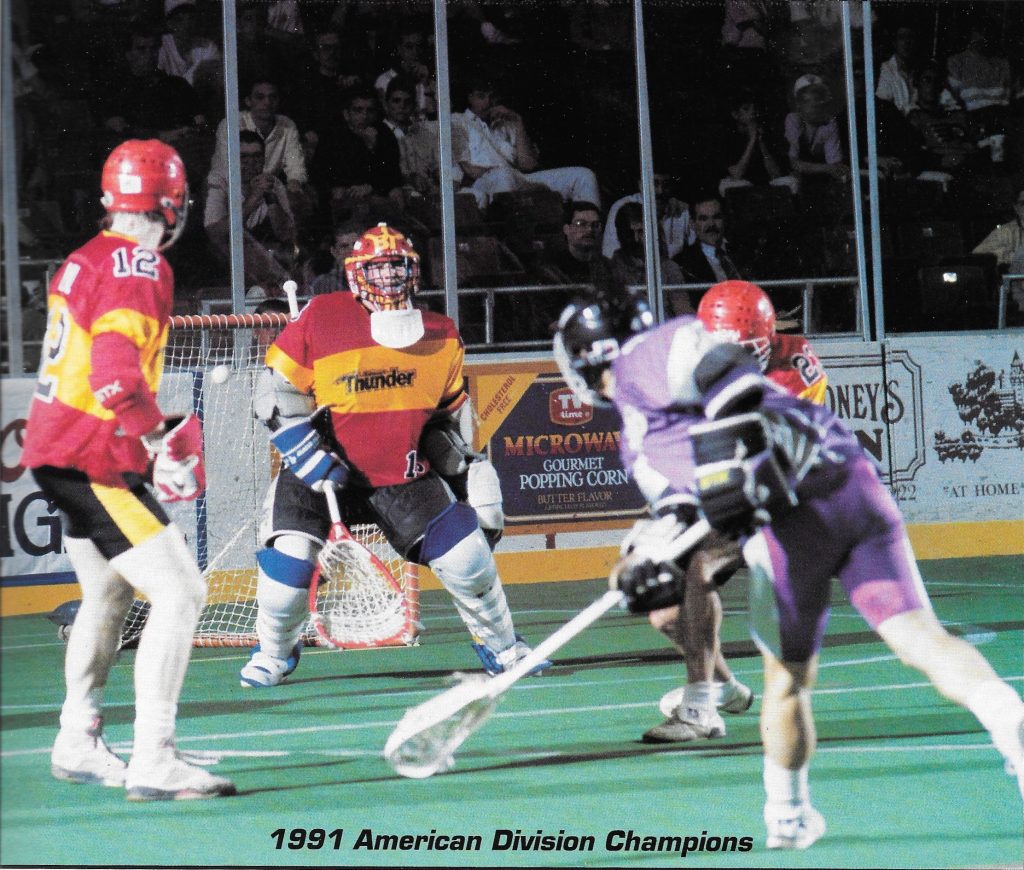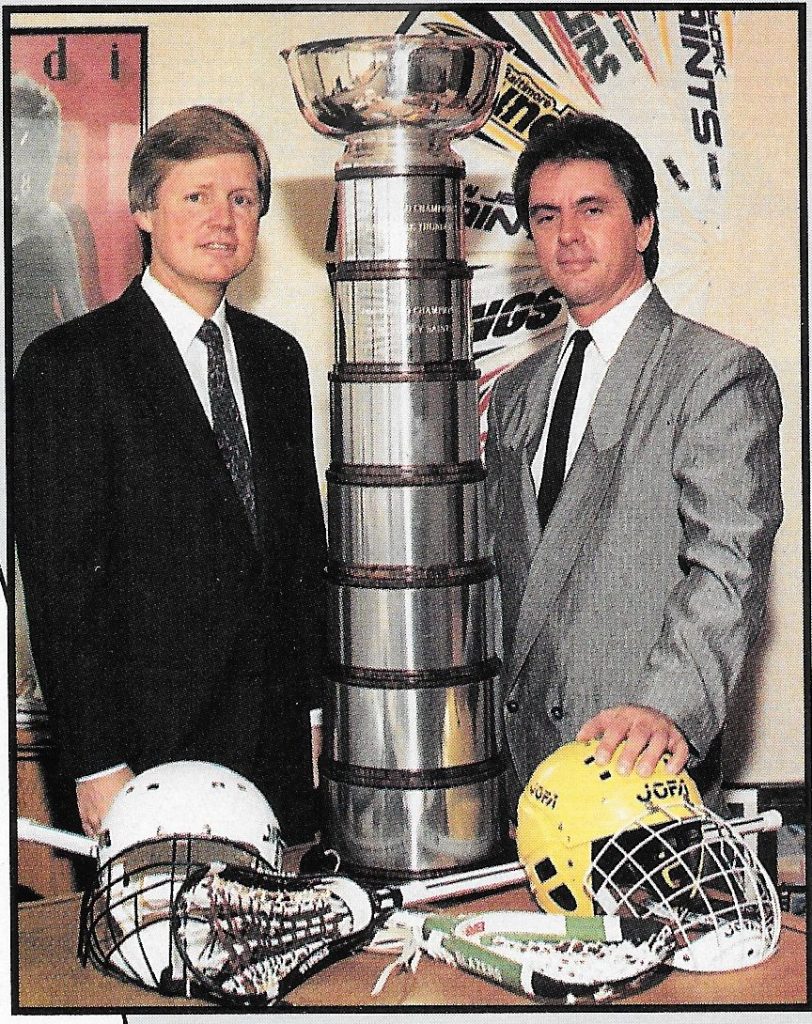Gary Gait, indoor lacrosse's biggest star, lives in town but can't play for Baltimore..
by Doug Brown The Baltimore Sun Feburary 13, 1992

Fancy meeting you here, Gary Gait.
Not far from Johns Hopkins, little more than a stone’s throw from the cradle of lacrosse, lives Gait with his wife of six months, Nicole.
This is, indeed, interesting. For four years, Gary and his twin brother, Paul, were the scourges of college lacrosse, leading Syracuse to three straight NCAA championships through 1990 and leaving Johns Hopkins and everyone else in their wake. Many said they were the best offensive players in the history of the game.
And now, in what was once for him enemy territory, resides Gary Gait, in a roomy unit in an apartment building in Homewood.
How come? What brought the Canadian here? A combination of things, it seems. The Haswell Franklin family, for one.
“Haswell Jr. was an assistant coach with the Canadian national team in the last two World Games,” Gait said. “I stayed at his father’s house on Charles Street many times when I came to Baltimore, made friends and grew to like the area.”
Gait signed an endorsement and promotional contract — to do clinics, sign autographs and the like — with STX Inc., a Maryland-based lacrosse equipment manufacturer. He got a full-time job in sales with Chesapeake Randall Co., a food brokerage firm at 25th and Charles.
So, why not Baltimore?
“Nicole and I didn’t want to live in the country or downtown, and it just so happened the Realtor brought us near Johns Hopkins,” Gait said.
In addition to working for STX, Gary and Paul Gait are Coors Lite spokesmen and endorse Nike products. Such are the perks that have come to the game’s most celebrated players.
The Gaits are still playing lacrosse, of course. They are the marquee names of the Major Indoor Lacrosse League, having led the Detroit Turbos to the championship last season in their rookie year. Only a year before the Turbos had a 1-7 record.
“Their skills indoors are unparalleled,” said Baltimore Thunder coach John Stewart. “With both on the same team, it’s twice as difficult for an opponent to prepare.”
That is what the Thunder will do this week: prepare for its game against the Gaits and the Turbos on Saturday at 8 p.m. at the Baltimore Arena.

The fact that the Gaits are both still with Detroit is a source of irritation to some MILL people. General managers and coaches agreed before last season to allow the league to place Gary and Paul on the same team.
“We wanted to keep the league going,” Stewart said. “On the other hand, what if Magic Johnson and Michael Jordan had come out of college the same year and the NBA had put them on the same team?”
While Thunder general manager Darrell Russell acknowledges that the Gaits give the MILL credibility, he chafes at the league’s stated “territorial imperative” that is often ignored.
The Thunder lost three players in the past year or two when they moved from Baltimore — John Nostrant to Philadelphia, John Heil to New York and Brian Lemon to Detroit. Lemon was the MVP in Detroit’s win over Baltimore in the championship game last April.
“We got virtually no compensation for those three,” Russell said. “Yet, when Gary Gait moved to Baltimore last fall, I asked the league about it and they just laughed at me. It was like, ‘Nice try, Darrell.’
“That hurts the league’s credibility. The packaging of the entertainment product seems to hold sway over the virtues of the sport. That’s what happens when you have two guys in Kansas City who own all seven teams.”

MILL president Chris Fritz and vice president Russ Cline can make up the rules as they go, and sometimes do. When Nostrant, Heil and Lemon moved, they were placed on other teams; when Gary Gait moved, he remained with the Turbos.
“Yes, it is inconsistent,” Cline said. “But if we broke up the Gaits, we’d have even worse problems in our efforts to survive.
“We’ve never fancied ourselves as the NFL or major-league baseball. We do things out of necessity to sustain pro lacrosse. And we’ve been around longer [six years] than any pro [lacrosse] league ever.”
Cline takes pains to point out that the Gaits are “paid no more than any other second-year players,” which is to say, $150 a game. Nobody is getting rich in pro lacrosse.
Gary Gait has a hectic schedule. This weekend, for example, he flew Friday night to Detroit for a 10 p.m. to midnight practice with the Turbos, followed by another workout yesterday from 8 to 10 a.m. and then a flight to New York for appearances at sporting goods stores. He is due back in Baltimore late tonight.
His brother has a similar schedule. Paul is still at Syracuse, completing work for his degree in marketing (Gary graduated with a political science degree), but joins Gary on weekends for practices, games and promotions work.
For all their skill and fame, the Gaits aren’t an overwhelming home attraction. In its three home games, Detroit has averaged 7,917, fifth among the MILL’s seven teams.
The Gaits do draw on the road, though. In their two away games, the Turbos drew 13,581 in Buffalo, N.Y., and 13,466 in New York.
Last season, they averaged 10,393 in two games in Baltimore — well above the Thunder’s average of 8,936 — and the arena has a reasonable expectation of 10,000-plus for Saturday’s game. The Thunder’s average this season is 8,206.







